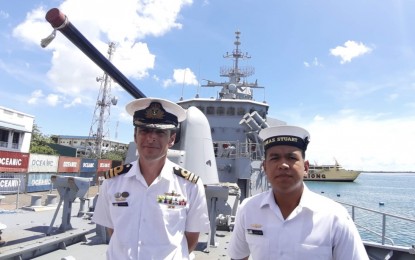
GOODWILL VISIT. Commander Luke Ryan (left), commanding officer of HMAS Stuart, an Anzac-class frigate of the Royal Australian Navy, stands with Seaman Darren Cruz, from Manila, as they answer media queries on board the vessel on Wednesday (Oct. 23, 2019). HMAS Stuart is in Cebu since Monday (Oct. 21) for a goodwill visit after participating with other Australian Navy and Philippine Navy vessels in the commemoration of the 75th anniversary of the Leyte Gulf Landings and the Battle of Surigao Strait. (PNA photo by John Rey Saavedra)
CEBU CITY -- HMAS Stuart, a long-range Anzac-class frigate of the Royal Australian Navy, on Wednesday allowed the media here to tour the vessel and to meet one of the six Filipino-Australian sailors.
Commander Luke Ryan, commanding officer of HMAS Stuart, said the vessel has been in Cebu since Monday (Oct. 21) for a goodwill visit after joining three other Australian naval vessels in commemorating the 75th anniversary of the Leyte Gulf Landings and the Battle of Surigao Strait.
Ryan presented Seaman Darren Cruz, a native of Manila who migrated to Australia since nine years of age and boarded the vessel to achieve his “dream job.”
Cruz, 21, said he applied in the Australian Navy to continue the kind of job he had when he was at a mining firm in Australia.
When asked why he joined the Royal Navy service, Cruz said he wanted to help the country (Australia). “Kasi po alam ko na joint po kami sa Pilipinas. Alam ko na kapag nandito ako may mabuti akong magawa para sa Pilipinas at sa Australia (It’s because I know the partnership between us and the Philippines. I know that if I am here, I can do something good for the Philippines and Australia),” Cruz said.
Cruz described his Australian colleagues aboard the vessel as “friendly, helpful and cheerful.”
According to Ryan, among the seven Filipinos of the 117 crew onboard the 3,600-ton frigate is Lt. Commander Marlou Ricamora, who also hails from Manila and works as “one of the heads of department in charge of all weapons and all the radars” of HMAS Stuart.
“He (Ricamora) is from Manila. He is a graduate of a university in Manila and then immigrated to Australia. He is ashore today to visit his mother,” the commanding officer said.
Ryan said other Filipino-Australian crews are working as medic and aircraft technicians tasked to fix the rescue helicopter attached to the HMAS Stuart and placed inside the hangar at the vessel’s aft portion.
When asked about the work attitude of the crew with a Filipino descent, Ryan said they are “very good.”
“Everyone on board is treated the same. Australia is an immigrant nation with people from all around the world including about 2,500 Filipinos,” Ryan said, underscoring the their advantage in having with them “seven members of the ship’s company that can speak Tagalog (Filipino), that can tell us the good restaurants to go to, help us engage the navy with the people of Cebu.”
Stuart has been famous with its World War II Anzac-class destroyer that led nine other destroyers to many major battles in the Mediterranean and many other large battles, he said.
“So we carry the name today to honor the legacy to those Australians that have boarded before us in many ships in times of war and in times of peace,” he added.
The GE LM2500 gas turbine engine-powered frigate has the capability for air defense, surface and undersea warfare, surveillance, reconnaissance and interdiction, with combat capabilities significantly improved under the Anti-Ship Missile Defence upgrade program.
Fitted with an advanced package of air and surface surveillance radars, Omni-directional hull-mounted sonar and electronic support systems that interface with the state-of-the-art 9LV453 Mk3E combat data system, it can counter simultaneous threats from aircraft, surface vessels, and submarines.
It has an armament of Mark 45, a shipborne missile canister launching system that is capable of firing 20 rounds per minute, ship launched Mark 46 torpedoes and Mark 41 vertical launch system for Evolve Sea Sparrow Missile, apart from the eight anti-ship/land attach canister launched harpoon missiles and the Nulka active missile decoy system, off-board chaff and torpedo countermeasures system. (PNA)
